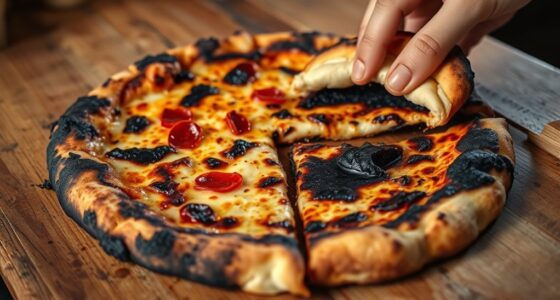To avoid a bitter taste from excess flour on your peel, use a light dusting of cornmeal or flour and tap off any excess before placing your dough. Minimize the amount of flour you apply initially by handling the dough gently and using a bench scraper or wet hands when transferring. Proper preparation creates a thin, even layer that prevents sticking without overpowering flavor. Keep practicing, and you’ll discover how to perfect your pizza slide and flavor further.
Key Takeaways
- Use minimal flour or cornmeal when preparing the peel to prevent excess residue.
- Tap off or gently shake off surplus flour before placing the dough on the peel.
- Lightly dust the peel with just enough flour to prevent sticking, avoiding over-application.
- Handle dough with wet hands or a bench scraper to reduce the need for extra flour.
- Practice proper dough resting and handling techniques to minimize sticking and reduce flour reliance.

When preparing to slide your pizza into the oven, too much flour on the peel can cause more trouble than you might expect. Excess flour creates a barrier that prevents the dough from sliding smoothly, often resulting in frustration and uneven cooking. To avoid this, understanding dough hydration is vital. Dough hydration refers to the ratio of water to flour in your dough, which directly impacts its stickiness and elasticity. If your dough isn’t properly hydrated, it may be too dry and prone to sticking, prompting you to add more flour to the peel. However, overdoing it can lead to a bitter taste and a tough crust. The key lies in mastering pizza dough techniques that balance hydration and handling.
Too much flour on the peel hinders smooth sliding, causing uneven cooking and frustration. Balance hydration and handling for best results.
Start by adjusting your dough’s hydration level. A well-hydrated dough tends to be more elastic and less sticky, reducing your need to use excessive flour when transferring it. Typically, a hydration level of around 60-65% works well for most styles, but this can vary depending on your flour type. Higher hydration doughs may be stickier, but they also produce lighter, airier crusts. When working with high-hydration doughs, use a bench scraper or wet hands to handle the dough, minimizing the need for flour on your peel. This technique keeps the dough intact and prevents it from tearing or sticking excessively. Additionally, proper dough fermentation enhances both flavor and gluten development, which can help reduce sticking and improve handling.
Your pizza dough techniques also involve proper preparation of the peel. Lightly dust the peel with flour or cornmeal, but avoid piling it on. Tap off any excess before placing your dough on it. This creates a thin, even layer that allows the dough to slide easily without leaving behind a bitter residue. If you notice the dough sticking, instead of adding more flour, try gently loosening it with a bench scraper or shifting it slightly to see if it frees up. Using a well-floured peel combined with correct dough hydration ensures you won’t have to rely on excessive flour to slide the pizza into the oven.
Additionally, letting your dough rest after shaping helps develop gluten structure, making it less sticky and easier to handle. Proper dough fermentation also enhances flavor and texture, reducing the temptation to add more flour to mask stickiness. By focusing on dough hydration and refined pizza dough techniques, you create a balance that minimizes sticking and prevents the bitter taste that can come from over-flouring. With practice, you’ll find that your pizzas slide effortlessly onto the baking surface, resulting in a crisp, flavorful crust without the bitterness or heaviness caused by excess flour.
Frequently Asked Questions
Can Using Less Flour Affect the Dough’s Texture?
Using less flour can positively affect your dough’s texture by improving dough elasticity, making it easier to shape and handle. It also reduces excess flour absorption, preventing a dry or dense crust. However, be careful, as too little flour might cause sticking or tearing. Finding the right balance guarantees your dough stays pliable and flavorful without sacrificing texture. Adjust gradually to discover what works best for your baking process.
Is There a Better Alternative to Flour for Preventing Sticking?
Yes, you can use an alternative coating like a light dusting of cornmeal or rice flour instead of regular flour to prevent sticking. Additionally, applying a non-stick spray to your pizza peel or baking surface creates a thin barrier that helps your dough slide off easily. These options reduce the risk of a bitter taste and mess, making it easier to transfer your pizza without compromising flavor or texture.
How Does Flour Type Influence the Bitter Taste?
Think of flour as a palette for your pizza—using a different type changes the flavor landscape. Whole wheat or rye flour can introduce a nutty or bitter note, amplifying taste bitterness, while rice or cornstarch keeps flavors neutral. Choosing a mild-flavored flour helps prevent bitterness and maintains the pizza’s natural taste. So, pick your flour wisely; it’s like selecting the right paint for your masterpiece.
Should I Remove Excess Flour Before Baking?
Yes, you should remove excess flour before baking. When you leave too much flour on the peel, it affects dough consistency and can cause a bitter taste. Gently brushing off or shaking off the surplus flour helps guarantee proper flour absorption during baking. This not only improves flavor but also prevents the crust from becoming overly dry or tough, giving you a better, more balanced pizza.
Does Ambient Humidity Impact Flour Application on the Peel?
Yes, ambient humidity impacts flour application on the peel. Higher humidity levels increase flour absorption, causing it to clump and stick more, which can lead to excess flour and a bitter taste. To avoid this, you should adjust the amount of flour you use based on the humidity, applying just enough to prevent sticking without overdoing it. Keep an eye on weather conditions to maintain the right balance.
Conclusion
Think of your pizza peel as a painter’s canvas—too much flour is like overloading it with paint, muddling the masterpiece. When you use just the right amount, your dough glides smoothly, revealing a perfect, flavorful crust. So, treat your peel like a delicate brush: a light dusting is enough to prevent sticking without spoiling the flavor. Master this, and your pizza will turn out as stunning and flawless as a work of art.









